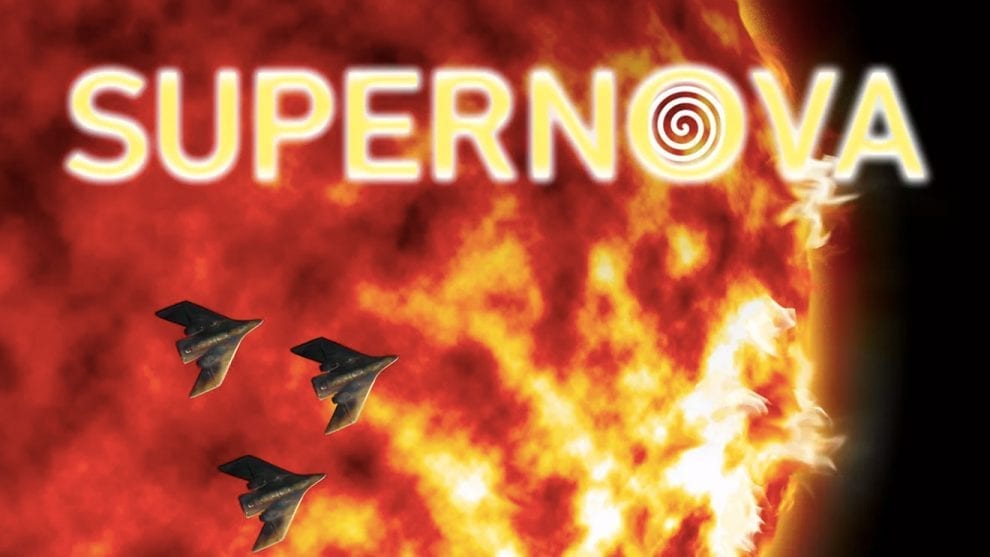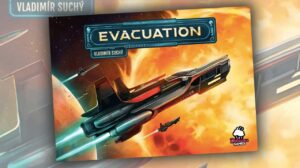Disclosure: Meeple Mountain received a free copy of this product in exchange for an honest, unbiased review. This review is not intended to be an endorsement.
The sci-fi strategy game Supernova, from Pandora Games, promotes itself in the age-old category of “easy to learn, difficult to master” in part because of a single game mechanic: moving your playing pieces in a spiral, as opposed to just moving them in a straight line inwards, towards a dying star located at the center of the game board.
It’s this one change that sets Supernova apart from other games; even when we agreed to review this game, a couple of the Meeple Mountain staff mentioned the similarities that Supernova has to games like Gravwell, a game which I have not played.
It’s also the one change that makes Supernova a difficult game to recommend. Read on to find out more!
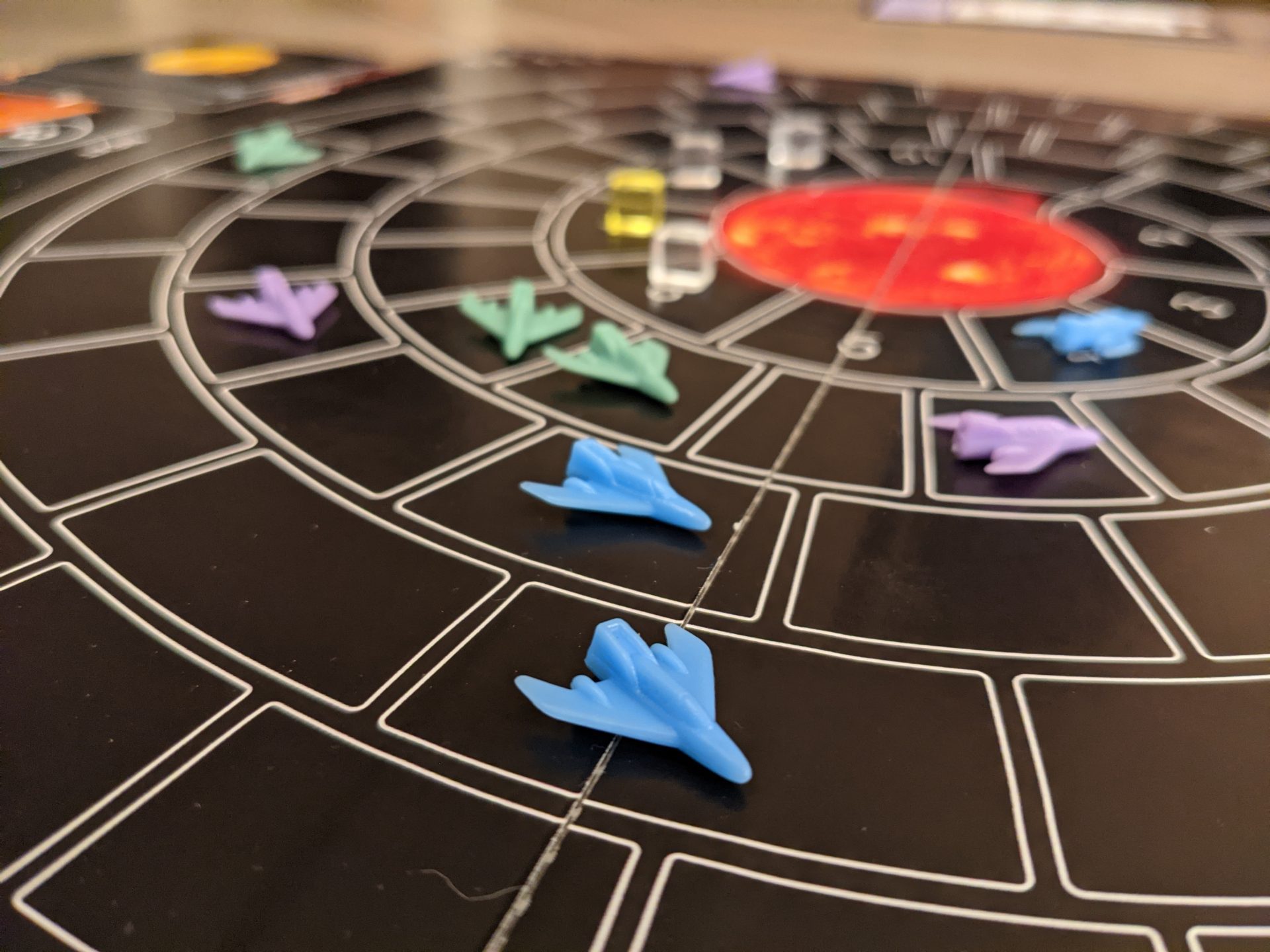
“Ahh! My head just HURTS!”
That’s the line my wife yelped out loud as she was trying to figure out all of the variables that were going to factor into her current move. (It’s fair to say that she did not enjoy playing this game.)
However, I understand her frustration, and I think there are a few reasons that led to this moment. First, let’s talk about the gameplay of Supernova.
Supernova is described as a suicide mission, where players are representing civilizations who are counting on the player to harvest enough energy to keep their communities alive. Over the course of playing event cards known as Star Cards (the total differs based on player count), rounds will feature players attempting to collect energy bursts to score end-game victory points. The game ends when all players lose all of their ships, or the final Star Card is played, which signals the final “supernova event”, where everything dies!
The board is a spiral of game spaces, starting from an outer ring all the way inwards to the supernova in the title. Each player starts the game with four ships, and on a turn, you need to find ways to move those ships slowly towards the supernova while collecting energy bursts which are spiraling outwards from the center. Three types of energy bursts will be coming your way: white (which are worthless in terms of points but upon collection can help trigger special abilities), yellow, and red. The latter two are the only ways to score points in Supernova. There are rules to collecting those bursts—represented by cubes on the board—because in some cases, those bursts can actually destroy your ship.
Moving those ships, and planning for future turns, is guided by determining your collective ships’ Power Profile at the start of your turn. You can select one, two or three of your ships to receive power on a turn. In those cases, powered ships can move towards or away from the supernova by 6, 4, or 3 spaces each for one, two or three ships respectively. In addition, all ships are gravitationally pulled towards the supernova some number of spaces too.
Just a couple of other things…
There are additional rules to movement—for example, if you land directly on a white cube, you get four additional points of movement on that turn. But if you don’t plan well, and a white cube is spun outwards from the supernova and lands directly on your ship, your ship is destroyed unless you spend a yellow cube to shield your single ship. (Yes, this could also mean that a player’s four ships could be destroyed, eliminating that person from the game. We haven’t had that happen yet before the final round, but it is possible.)
Also testing your planning prowess are various ship formations, which if you can math out how to situate your ships at the end of each turn, you can use those formations to be better at protecting your own ships, using shields to protect against white cubes possibly destroying your ship, or setting up a U-shape formation that makes collecting white cubes significantly easier.
The basic rules are somewhat simple to grasp in Supernova. But when considering how to move your ships and plan for future turns? I had to admit, it was hard. Really hard. And I think that starts with how to think in spirals, which the designers spend an entire page discussing in the instruction manual.
If Supernova utilized a board where all player ships started at the bottom and then needed to fly up the board towards the supernova, while grabbing energy bursts along the way, I have a feeling this would be too easy. So, I certainly get why the board is designed the way it is and I like the look of it.
But here’s where things get tricky. Each turn, you have to determine how many spaces your ships will be pulled TOWARDS the supernova. And you have to plan for how your ships will move based on the power profile. All of this is done in a pool of action points, described before.
Let’s say gravitational pull this round is six (this changes literally every round). Let’s also suppose you want to power three ships, meaning each ship can “boost” itself for three action points (spaces) in any direction. Then, let’s also suppose that each energy burst will move outwards eight spaces on this turn (this also changes literally every round). And you have four ships. And you have to then, in ship order from closest to the supernova to farthest from the supernova, move each ship and tell other players if that specific ship will be powered or not.
And if you stop your movement on any given white cube, you actually boost for four more action points/spaces. In a bit of a twist, the ship that ends on a white cube doesn’t get to use those boost points; those are distributed to other ships you own which have not been powered yet on the same turn. So then, you’ve got to plan for how you’ll spend those extra points. Then you have to make sure you’ve set yourself up so that you are shielded just in case there are any white cubes coming your way which might end their turns on top of your ship, because if that happens, you’ll lose a ship.
You see where this is going. The analysis paralysis even in a two-player game can be absolutely brutal in Supernova, but I see why the design is set up this way; my wife, during our first game, said it best:
“This is the kind of game I would definitely give to a chess player.”
Here’s the rub: I don’t play chess.
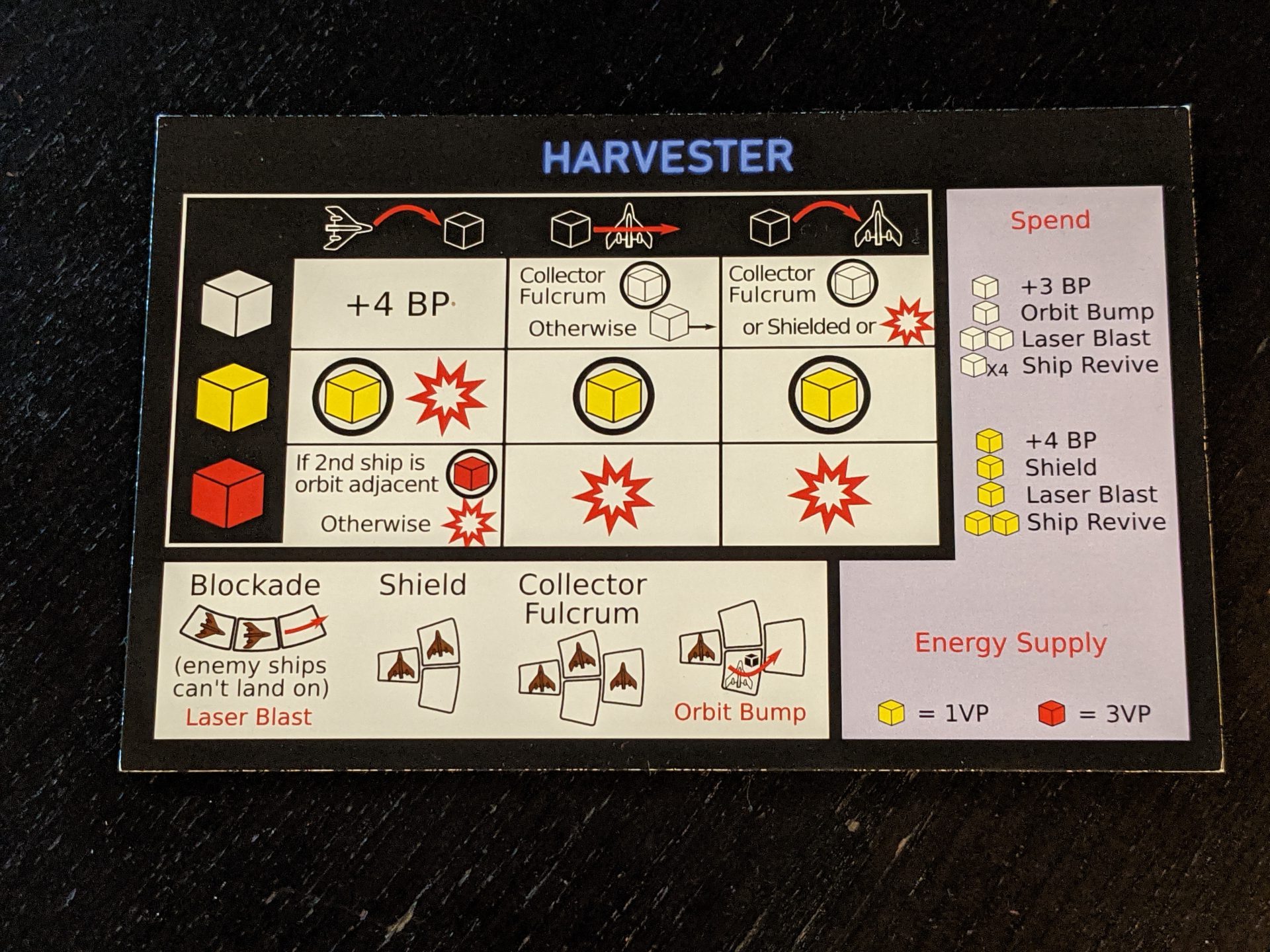
Pass the Brainiac
I do think Supernova has an audience: really smart, patient people who are comfortable with a “space” game that’s very light on theme. Also, because the board and components in our prototype copy were pretty spartan, this is not the bling you are looking to break out alongside something magnificently produced, like Twilight Imperium or Eclipse: Second Dawn for the Galaxy. The cards, cubes, board and ships are absolutely, totally basic. (I’m very excited to see what the final production of Supernova brings to the table.)
You are here for the gameplay. And the math. And for a certain kind of person, Supernova could really work well. As I finished my first play when my wife broke out her signature line, I took a moment to pivot: who will enjoy playing this game?
I named a couple of specific friends who do well in environments where there is not much talking and well-planned turns are rewarded with points to win the game. Also, I have a couple of friends who hate “point salad”-style Euros; this is not that, by a long stretch. You might end up with eight points and win, especially at a higher player count, and you’ll have really earned all eight of those points. In my most recent play, a three-player game that took just under two hours, the winners tied with 10 points each while I had 9 points. And both of the winners had at least one really cool, multi-cube scoring turn where they were able to math out perfect ways to balance their ships’ collective Power Profile with figuring out where a couple of yellow cubes were going to be.
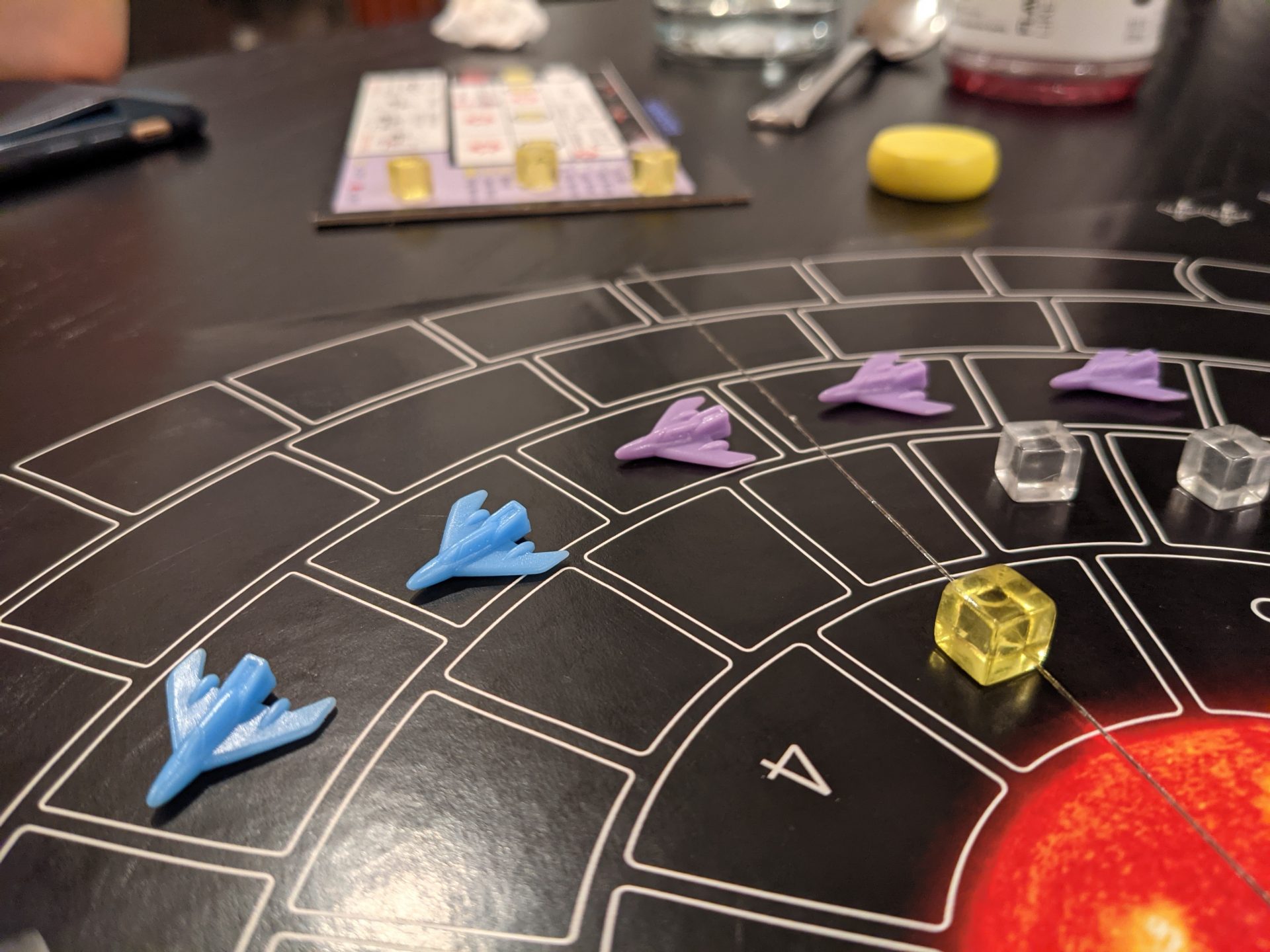
A few additional thoughts and the verdict!
A note on player count: I would never play Supernova at more than three players. At four, and definitely at five, players, I can’t even imagine the downtime, especially because of the first-player mechanic. If you go first in a round of a four-player game, and then the first-player token is passed to the left, you are effectively taking your next turn eight turns later (three players, then a cleanup, then three more players before taking your next turn). Unless the other players are mostly out of ships—a scenario that will happen, especially late in a game—that’s a long time to sit watching others do all of the math required.
Another player made a suggestion during a three-player runthrough of Supernova. It would really help those of us who are slightly math challenged to have not just the first 10 spaces working away from the center of the board numbered, but ALL of the spaces on the board numbered. I get it—not sexy, in terms of board aesthetics. But on essentially every turn, you will need to count out where you need to end a turn to not be in a space that could destroy one of your ships.
Some minor things with my prototype copy will likely be sorted by the time final production hits a player’s table. The writing on the Star Cards can be a little tough to read, especially for anyone trying to read red numbers on a yellow-red background. Most of the spaces allow for movement from another orbit ring from multiple spaces, but a few near the center are aligned right next to the most directly outward orbit ring; this becomes important when setting up shield alignments for your ship, or grabbing the red cubes, which is already a mind boggling exercise to begin with. The current rules for Supernova do not feature a tiebreaker; this will certainly be added, because in such a low-scoring game ties will happen from time to time.
Overall, I really think there is something rich here in Supernova for the right kind of player profile. While I am not that kind of gamer, the patient, high-IQ individual who enjoys a good puzzle will really enjoy Supernova; finding those fun moments to grab cubes will be very satisfying to the appropriate audience.
Check out the Kickstarter campaign to learn more about Supernova!


